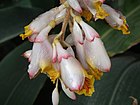Note: This is a project under development. The articles on this wiki are just being initiated and broadly incomplete. You can Help creating new pages.
Difference between revisions of "Elettaria cardamomum - Ela, Cardamom"
(→List of Ayurvedic medicine in which the herb is used) |
(→References) |
||
| Line 78: | Line 78: | ||
<references> | <references> | ||
| − | <ref name="chemical composition">[https://essentialoils.co.za/essential-oils/cardamom.htm | + | <ref name="chemical composition">[https://essentialoils.co.za/essential-oils/cardamom.htm Plant Chemicals]</ref> |
| − | <ref name="Leaf">[http://powo.science.kew.org/taxon/urn:lsid:ipni.org:names:796556-1 " | + | <ref name="Leaf">[http://powo.science.kew.org/taxon/urn:lsid:ipni.org:names:796556-1 "Leaf morphology"]</ref> |
| − | <ref name="How to plant/cultivate">[https://www.indiaagronet.com/indiaagronet/crop%20info/Cardamom.htm | + | <ref name="Ayurvedic preparations">[https://easyayurveda.com/2014/12/26/cardamom-uses-research-home-remedies-side-effects/ Ayurvedic preparations]</ref> |
| + | |||
| + | <ref name="How to plant/cultivate">[https://www.indiaagronet.com/indiaagronet/crop%20info/Cardamom.htm Cultivation details]</ref> | ||
</references> | </references> | ||
Revision as of 14:23, 6 June 2019
Elettaria cardamomum is a herbaceous perennial plant in the ginger family, native to southern India. It is the most common of the species whose seeds are used as a spice called cardamom. It is cultivated widely in tropical regions and reportedly naturalized in Réunion, Indochina and Costa Rica.
Contents
- 1 Uses
- 2 Parts Used
- 3 Chemical Composition
- 4 Common names
- 5 Properties
- 6 Habit
- 7 Identification
- 8 List of Ayurvedic medicine in which the herb is used
- 9 Where to get the saplings
- 10 Mode of Propagation
- 11 How to plant/cultivate
- 12 Commonly seen growing in areas
- 13 Photo Gallery
- 14 References
- 15 External Links
Uses
Indigestion, Nausea, Vomiting, Pulmonary disease, Stomachache, Heart burn, Throat troubles, Congestion of the lungs, Kidney stones
Parts Used
Chemical Composition
The main chemical components of cardamom oil are a-pinene, b-pinene, sabinene, myrcene, a-phellandrene, limonene, 1,8-cineole, y-terpinene, p-cymene, terpinolene, linalool, linalyl acetate, terpinen-4-oil, a-terpineol, a-terpineol acetate, citronellol, nerol, geraniol, methyl eugenol and trans-nerolidol.[1]
Common names
| Language | Common name |
|---|---|
| Kannada | Elakki |
| Hindi | Elaichi |
| Malayalam | Elatarri |
| Tamil | Elam Ancha |
| Telugu | Elaki |
| Marathi | NA |
| Gujarathi | NA |
| Punjabi | NA |
| Kashmiri | NA |
| Sanskrit | Trutih |
| English | Cardamom, Malabar cardamom |
Properties
Reference: Dravya - Substance, Rasa - Taste, Guna - Qualities, Veerya - Potency, Vipaka - Post-digesion effect, Karma - Pharmacological activity, Prabhava - Therepeutics.
Dravya
Rasa
Katu (Pungent), Madhur (Sweet)
Guna
Laghu (Light), Ruksha (Dry)
Veerya
Sheet (cold)
Vipaka
Katu (Pungent)
Karma
Kapha, Vata
Prabhava
Habit
Identification
Leaf
| Kind | Shape | Feature |
|---|---|---|
| Simple | long and sword-shaped | The underside is paler and may have a covering of tiny hairs and it is Dark green |
Flower
| Type | Size | Color and composition | Stamen | More information |
|---|---|---|---|---|
| Unisexual | Reach over 1 m in length | pale green | 5-20 | The flowers contain both male and female parts. One of the petals is white and streaked with violet |
Fruit
| Type | Size | Mass | Appearance | Seeds | More information |
|---|---|---|---|---|---|
| oval-shape | Each fruit has three chambers filled with small aromatic seeds, each about 3 mm long | The fruits dry to a straw-brown colour and are widely used as flavouring | seeds dry to a straw-brown colour and are widely used as flavouring | {{{6}}} |
Other features
List of Ayurvedic medicine in which the herb is used
Where to get the saplings
Mode of Propagation
How to plant/cultivate
The planting is carried out during the rainy season commencing from June. Seedlings are to be planted upto the collar region for better growth. Cloudy days with light drizzle are ideal for planting. Generally in Kerala and Tamil Nadu, the seedlings are transplanted in March-May at a spacing of 20x 20 cm and mulched immediately. Beds are to be covered with an over head pandal and should be watered regularly.[4]
Commonly seen growing in areas
Subtropical area, Indoors in a heated greenhouse, Warm shady humid place.
Photo Gallery
References
External Links
- Ayurvedic Herbs known to be helpful to treat Indigestion
- Ayurvedic Herbs known to be helpful to treat Nausea
- Ayurvedic Herbs known to be helpful to treat Vomiting
- Ayurvedic Herbs known to be helpful to treat Pulmonary disease
- Ayurvedic Herbs known to be helpful to treat Stomachache
- Ayurvedic Herbs known to be helpful to treat Heart burn
- Ayurvedic Herbs known to be helpful to treat Throat troubles
- Ayurvedic Herbs known to be helpful to treat Congestion of the lungs
- Ayurvedic Herbs known to be helpful to treat Kidney stones
- Herbs with Seed used in medicine
- Herbs with Fruits used in medicine
- Herbs with common name in Kannada
- Herbs with common name in Hindi
- Herbs with common name in Malayalam
- Herbs with common name in Tamil
- Herbs with common name in Telugu
- Herbs with common name in Sanskrit
- Herbs with common name in English
- Habit - Herb
- Index of Plants which can be propagated by Seeds
- Index of Plants which can be propagated by Cuttings
- Herbs that are commonly seen in the region of Subtropical area
- Herbs that are commonly seen in the region of Indoors in a heated greenhouse
- Herbs that are commonly seen in the region of Warm shady humid place
- Herbs
- Zingiberaceae







